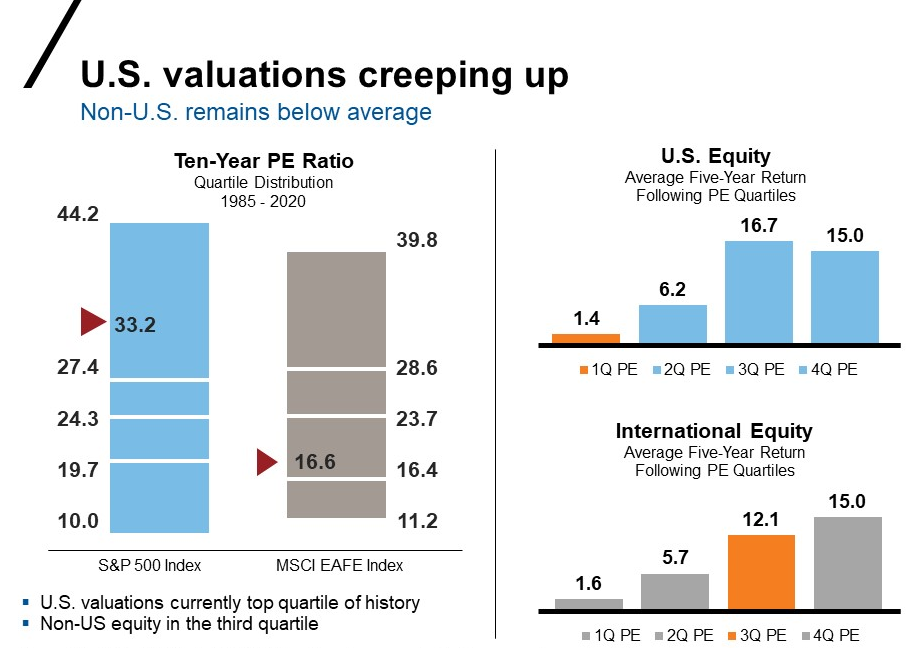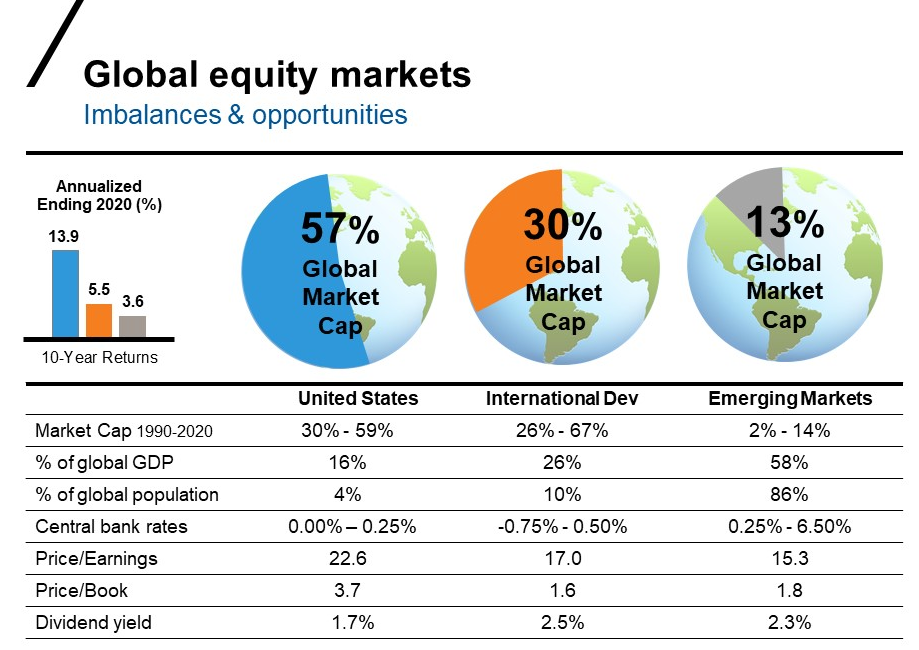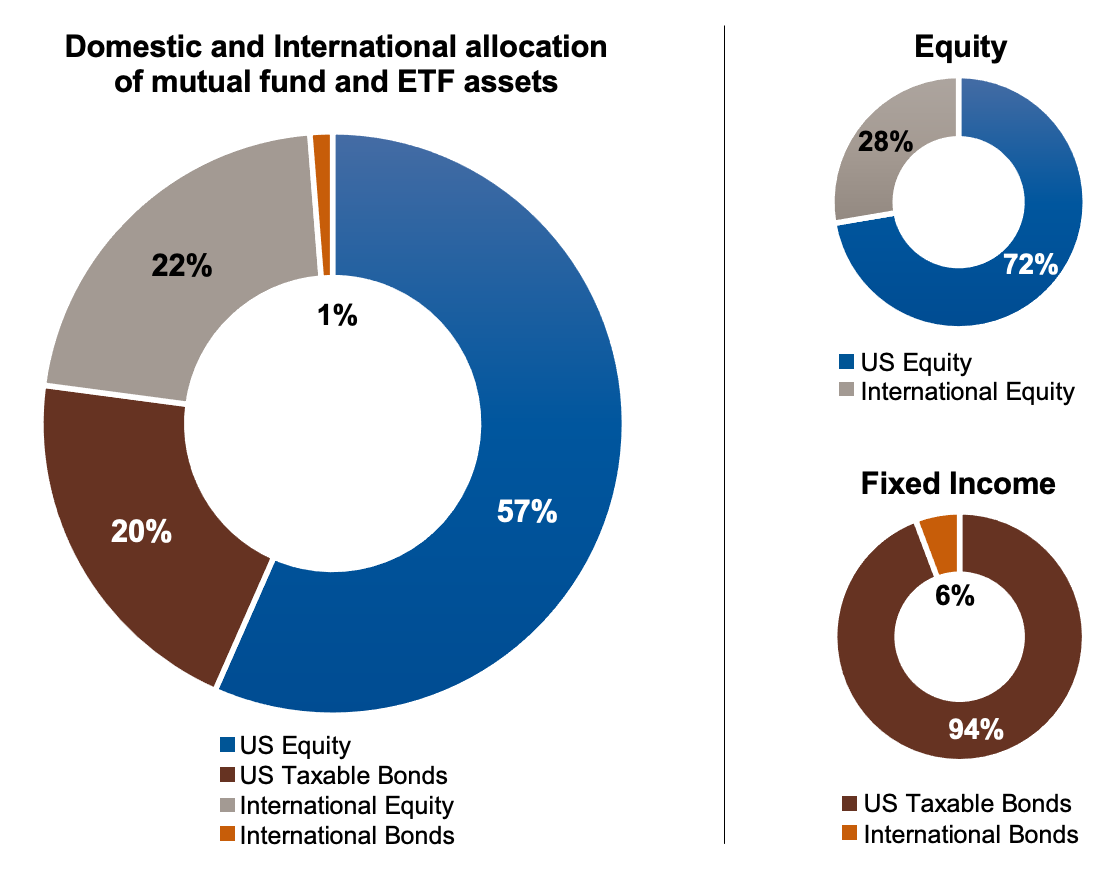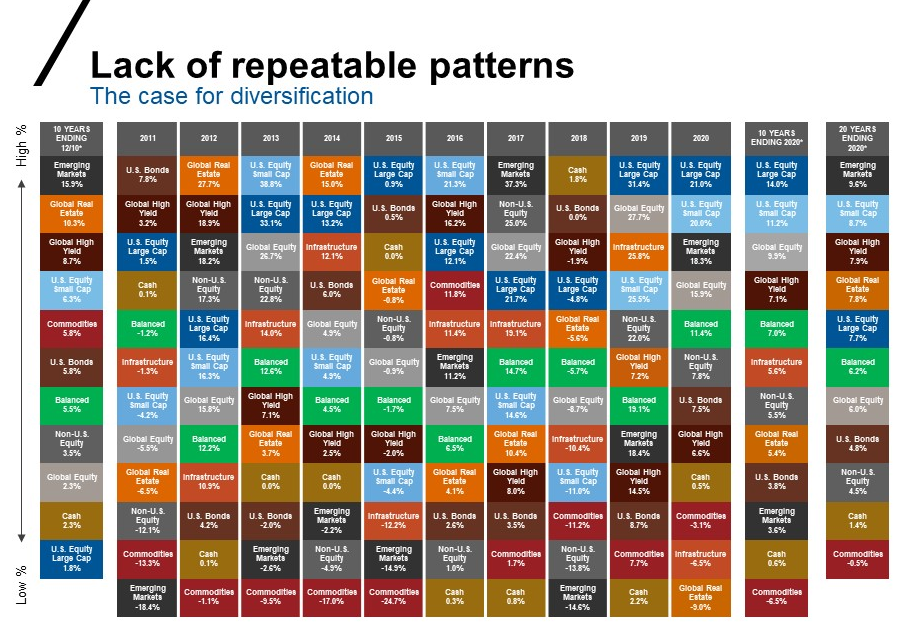by Michael Montemayor, Russell Investments
If your clients are like most U.S. investors, they may be reluctant to invest globally right now. You may find a similar home-country bias in your clients' asset allocation as in the charts below. Additionally, you could be hearing: I don’t see the benefit in investing outside the U.S. or questions such as: Why would we invest outside the U.S. when it has been the leading region for the past decade? Don’t worry—you’re not alone. Many advisors I work with are having these difficult client conversations. But the reality is that these conversations don’t have to be something you avoid and can potentially be much-needed discussions.
Click image to enlarge
Source: Morningstar Direct. Data as of 12/31/2020.
I’ve come up with three stories you can use in your client conversations that may help investors see the benefit of investing outside the U.S. Furthermore, I offer three timely facts you can use within these conversations that may provide a little extra proof for those clients who require more convincing.
A good story can help get your point across and complement your facts and figures. Try some of these stories or analogies. Or come up with your own to help clients see the benefit of investing beyond America’s borders.
Story #1: Just because it worked last season doesn’t mean it will work this season
I am a big fantasy football fan. In years past, I have used the strategy of only selecting my team from the highest-scoring players of the previous season. I felt good about this plan as I expected them to perform as well in the upcoming year. However, after the start of the season I quickly realized this strategy wasn’t foolproof, as many players were injured, or hampered due to external factors such as coaching or teammate issues that didn’t allow them to play to their full ability. When selecting a winning team, there is a lot more to consider than just what worked well last year.
This also applies to the financial markets. Just because U.S. large-cap equity was the best asset class to be in last year, or even the last 10 years, doesn’t mean it will be the best next year or should represent a large percentage of your portfolio. Asset class leadership rotates, and investors need to consider factors that could propel changes in this leadership.
Click image to enlarge
*Annualized return. Non-U.S. Equity – MSCI EAFE Index; Global Equity – MSCI World Index; Emerging Markets – MSCI Emerging Markets Index; Global Real Estate – FTSE NAREIT All Equity Index (1/1/1995-2/18/2005) & FTSE EPRA/ Developed Index (2/18/2005-12/31/2019); Cash – Bloomberg Barclays US Treasury Bill 1-3 Month Index; Global High Yield – Bloomberg Barclays Global High Yield Index (1/1/1990-12/31/1997) & BofAML Global High Yield TR Hdg Index(12/31/1997-12/31/2019); Infrastructure – S&P Global Infrastructure Index; U.S. Bonds – Bloomberg Barclays U.S. Aggregate Bond Index; U.S. Equity Large Cap – Russell 1000® Index. Balanced: 30% Russell 3000® Index; 35% Bloomberg Barclays U.S. Aggregate Bond Index; 20% MSCI EAFE Index; 5% MSCI Emerging Markets Index; 5% FTSE EPRA/NAREIT Developed Index; 5% Bloomberg Commodity Index. Please note that this chart is based on past index performance and is not indicative of future results. Indexes are unmanaged and cannot be invested in directly. Index performance does not include fees and expenses an investor would normally incur when investing in a mutual fund. Diversification and strategic asset allocation do not assure profit or protect against loss in declining markets.
Story #2: Buy low/sell high and look for a deal
When you are in the market for something, one of the first things you do is research the available products; the second is search for a deal or sale. Cost is extremely important because this is how you typically get the most bang for your buck over time. Furthermore, I am sure we all have learned that just because something is expensive doesn’t mean it is always good quality or the best option.
This is very similar to investing. To get the most bang for your buck, you need to try to find stocks or asset classes that are selling at a discount and try to limit buying securities at or near their peaks. When taking price-to-earnings (P/E) ratios into consideration, U.S. equity is currently closer to its peak compared to global equities. We recommend looking for asset classes where you can potentially get more bang for your buck right now.
Click image to enlarge

Sources: Robert Shiller, S&P500 Index, MSCI EAFE Index. Index returns represent past performance, are not a guarantee of future performance, and are not indicative of any specific investment. Indexes are unmanaged and cannot be invested in directly.
Story #3: The international jet
Last year, my flight home from a vacation in Costa Rica was delayed. We were all on board the plane and sitting on the tarmac. The pilot came over the loudspeaker and let us know we were going to have to wait a bit. He said the plane had a full tank, the landing gear and the other mechanical parts were working properly, and although the plane was ready, the flying conditions were not the best. We would have to wait for conditions to improve before we could take off.
This is a lot like what is going on in the international investing space right now. The fundamentals for non-U.S. companies are good such as P/E ratios (valuations), dividends, growth potential and more, but the investing conditions such as consumer sentiment, COVID-19 pressures and other factors are prohibiting the space from taking off. Once these conditions clear up, we could see the international jet take off.
When clients prefer facts to stories
Stories can help create sticky memories, but some clients prefer the cold, hard facts. Consider these facts and charts regarding global investing in your upcoming conversations:
1. International stock valuations are much lower than their U.S. counterparts. If you look at valuation metrics in the chart immediately above, you will see the 10-year P/E ratios listed. The U.S. is at 33.2 where the MSCI EAFE Index 10-year P/E ratio is at 16.6. Where can you get more bang for your buck right now?
2. Emerging markets and international developed regions combined make up 84% of the global GDP and 96% of the global population, while the U.S. only makes up 16% of the GDP and 4% of the global population, as shown below:
Click image to enlarge

Sources: S&P 500 Index, MSCI EAFE Index, MSCI Emerging Markets Index, International Monetary Fund, World Bank. Index returns represent past performance, are not a guarantee of future performance, and are not indicative of any specific investment. Indexes are unmanaged and cannot be invested in directly. Numbers may not add due to rounding.
3. The Bank of America’s Global Fund Manager Survey (FMS) for November 2020 shows that more investors prefer allocating funds to emerging markets (EM) now: “FMS conviction in Emerging Markets is on the rise. Net 36% of investors are overweight EM equity and the largest proportion ever saying EM currencies are undervalued,” Bank of America said.1 The survey also showed a 24% monthly increase in preference for emerging markets, the largest one-month increase since April 2017. Emerging markets are now the preferred region among global fund managers.
In our recently published Global Market Outlook, Russell Investments also likes the value in emerging markets equities. We believe China’s early exit from the lockdown and stimulus measures should benefit EM more broadly, as will the recovery in the global demand and a weaker U.S. dollar.
The bottom line
Any discussion about the inclusion of non-U.S. equities in a portfolio should likely begin with an acknowledgement of the obvious: U.S. equities have outperformed their non-U.S. counterparts by a significant margin over the past 10 years. The S&P 500 Index 10-year annualized return of 13.88 (as of 12/31/20) easily outpaces the MSCI ACWI ex USA 10-year annualized return at 4.92% (as of 12/31/20).2
However, even though U.S. equities have been on a historic tear for more than a decade, market dynamics and investor preferences continuously shift. As financial professionals, we believe it’s beneficial to educate clients on the importance of looking beyond our borders. A mix of stories and facts may help investors see the benefit of investing outside the U.S.
2 Source: https://www.msci.com/documents/10199/86494e1f-914e-4aa5-82a9-2e29ed5adbbf
Copyright © Russell Investments


















